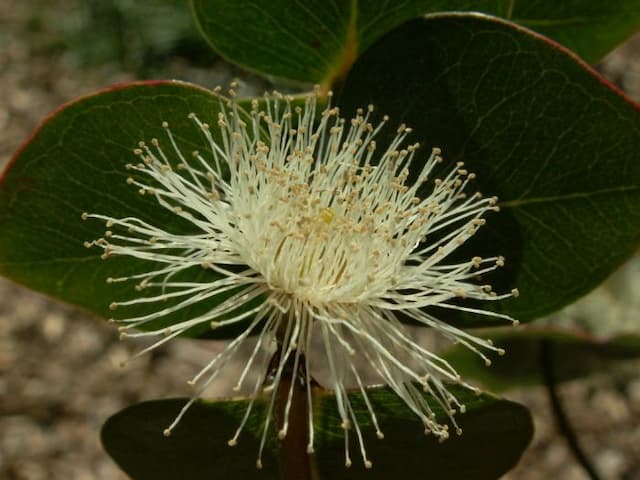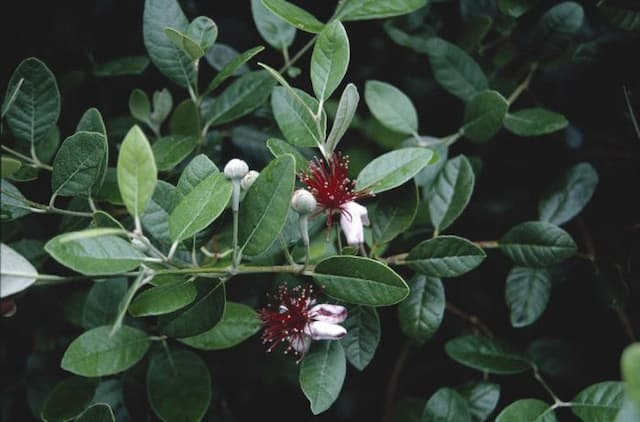Narrow-leaved Bottlebrush Callistemon linearis

ABOUT
Callistemon linearis, commonly known as the narrow-leaved bottlebrush, is a striking shrub characterized by its distinctive cylindrical, brush-like flowers. The flowers are typically a brilliant red, though they can occasionally be found in shades of pink or even greenish hues. These dramatic blossoms are composed of numerous individual flowers with long, protruding stamen, which give them the appearance of a traditional bottle brush. The plant's foliage is comprised of slender, linear leaves that are often arranged alternately along the stems, and they usually have a glossy texture with a firm and slightly leathery feel. The leaves are generally a vibrant green color, emphasizing the contrast with the bright flowers. The narrow-leaved bottlebrush can vary in its habit, sometimes presenting a weeping form with branches that drape gracefully. This plant is particularly loved by pollinators like bees and birds, who are attracted to the splashy flowers and the nectar and pollen they contain. The overall appearance of Callistemon linearis is one that is both architectural and ornamental, making it a popular choice for gardeners looking to add a touch of drama and natural beauty to their landscapes.
About this plant
 Names
NamesFamily
Myrtaceae
Synonyms
Narrow-leaved Bottlebrush, Slim Bottlebrush
Common names
Melaleuca linearis, Callistemon salignus, Melaleuca salicina, Callistemon brachyandrus.
 Toxicity
ToxicityTo humans
The common name for Callistemon linearis is the Narrow-leaved Bottlebrush. This plant is generally considered non-toxic to humans. There is no widespread documentation of toxicity from ingesting or contacting parts of the Narrow-leaved Bottlebrush. However, like with any plant, individuals may have allergic reactions or sensitivities. If symptoms do arise from contact or ingestion, it is recommended to consult with a healthcare professional.
To pets
The Narrow-leaved Bottlebrush, which is the common name for Callistemon linearis, is not known to be toxic to pets. It is not listed among plants that are commonly toxic to dogs or cats. While it seems to be generally safe, pets may still experience mild stomach upset if they ingest parts of this plant, as they can with any non-food item. If any unusual symptoms occur after ingestion, it is advisable to contact a veterinarian.
 Characteristics
CharacteristicsLife cycle
Perennials
Foliage type
Evergreen
Color of leaves
Green
Flower color
Red
Height
6-10 feet (1.8-3 meters)
Spread
4-6 feet (1.2-1.8 meters)
Plant type
Shrub
Hardiness zones
9
Native area
Australia
Benefits
 General Benefits
General Benefits- Aesthetic Appeal: Callistemon linearis, commonly known as the Narrow-leaved Bottlebrush, showcases vibrant red flowers that add striking visual interest to any landscape or garden.
- Attracts Wildlife: The bright blooms attract pollinators, such as bees and birds, which can help pollinate other plants in the garden.
- Drought Tolerance: Once established, the Narrow-leaved Bottlebrush is highly tolerant to drought, making it a suitable choice for xeriscaping and water-wise gardens.
- Low Maintenance: It requires minimal care once established, making it an easy plant for gardeners of all skill levels to grow.
- Soil Versatility: It can adapt to a range of soil types, though it prefers well-draining soils, which makes it versatile for different garden conditions.
- Wind Resistance: The plant is relatively hardy against strong winds, making it suitable for coastal or exposed areas.
- Habitat Restoration: It can be used in native planting schemes to help restore natural habitats and support native wildlife.
- Foliage Interest: In addition to its flowers, the Narrow-leaved Bottlebrush has attractive, slender foliage that provides textural contrast in the landscape.
 Medical Properties
Medical PropertiesThis plant is not used for medical purposes.
 Air-purifying Qualities
Air-purifying QualitiesThis plant is not specifically known for air purifying qualities.
 Other Uses
Other Uses- Callistemon linearis, commonly known as the Narrow-leaved Bottlebrush, can be used as a natural dye source, providing shades of green and yellow depending on the mordant used.
- The wood of the Narrow-leaved Bottlebrush is often used for small woodworking projects, including crafting decorative items and turning on a lathe due to its fine grain.
- The fibrous bark of the plant has been used historically in crafting, for making items such as ropes and woven goods.
- Nectar from the bottlebrush flowers can be used to make a sweet, floral honey when collected by bees, known for its unique flavor.
- Essential oils derived from the Narrow-leaved Bottlebrush leaves are sometimes used in perfumery and aromatherapy for their uplifting scent.
- The dense foliage serves as effective erosion control when planted on slopes or in areas prone to soil degradation.
- The plant can be used in xeriscaping, a landscaping method that reduces or eliminates the need for supplemental water from irrigation.
- Narrow-leaved Bottlebrush can be planted as a windbreak or privacy screen due to its dense growth habit and height.
- The flowers can be used in dried floral arrangements, retaining their shape and color for extended periods.
- As a source of biomass, the Narrow-leaved Bottlebrush can contribute to the production of bioenergy through the combustion of pruned branches and leaves.
Interesting Facts
 Feng Shui
Feng ShuiThe Bottlebrush plant is not used in Feng Shui practice.
 Zodiac Sign Compitability
Zodiac Sign CompitabilityThe Bottlebrush plant is not used in astrology practice.
 Plant Symbolism
Plant Symbolism- Resilience: Callistemon linearis, commonly known as the Narrow-leaved Bottlebrush, often thrives in tough conditions, symbolizing the ability to endure and persist.
- Healing: The plant has been used in traditional remedies, representing the healing of both physical and emotional wounds.
- Celebration: With its vibrant, brush-like flowers, the Narrow-leaved Bottlebrush symbolizes festivities and joyous occasions.
- Protection: In some cultures, the plant is believed to have protective qualities, which is why it may be planted around homes.
- Purification: The plant's association with water and its cleansing action when used in infusions can represent the purification of the mind and spirit.
 Water
WaterFor the Bottlebrush plant, Callistemon linearis, water deeply until moisture seeps out of the drainage holes, then allow the soil to nearly dry out before watering again. This will usually equate to watering once a week during active growth periods in spring and summer, but the frequency may decrease to once every two to three weeks during winter. It is important to avoid overwatering, making sure the plant is not left sitting in water. In terms of the amount, watering with approximately 1 to 1.5 gallons every time should suffice, but always check the soil moisture level as a guide.
 Light
LightBottlebrush plants thrive in full sun exposure, so place Callistemon linearis where it can receive at least 6 to 8 hours of direct sunlight daily. An ideal spot for the plant would be in a south-facing garden or near a south-facing window where it gets ample light. Inadequate light may result in less vigorous growth and fewer flowers.
 Temperature
TemperatureThe Bottlebrush, Callistemon linearis, prefers warmer climates and does best between 50°F and 90°F. It can survive minor frosts, but temperatures below 20°F may damage the plant. Ideally, keep the plant in an environment where temperatures do not drop significantly lower than 40°F at night.
 Pruning
PruningPrune Bottlebrush plants to maintain shape and encourage bushier growth. Pruning is best done after flowering, typically in late spring or early summer, by removing any spent flower spikes and shaping the plant as desired. Regular pruning is not required; doing so annually or biennially is generally enough.
 Cleaning
CleaningAs needed
 Soil
SoilBottlebrush plants prefer well-draining soil rich in organic matter with a slightly acidic to neutral pH between 6.0 and 7.0. A good soil mix for bottlebrush consists of equal parts peat, loam, and coarse sand. Regularly check the pH to ensure it remains optimal for the plant’s health.
 Repotting
RepottingBottlebrush plants should be repotted every 2-3 years to encourage healthy growth. Choose a pot that is only slightly larger than the previous one because a too-large pot can lead to water retention and root rot. Repot in spring before the new growth starts.
 Humidity & Misting
Humidity & MistingBottlebrush plants do well in moderate to high humidity levels. They are adaptable but prefer a humidity level of around 40-50%. If the indoor air is too dry, occasional misting can help raise the humidity around the plant.
 Suitable locations
Suitable locationsIndoor
Place near a sunny window; water when the topsoil is dry.
Outdoor
Full sun, protect from frost, water when dry, prune as needed.
Hardiness zone
9-11 USDA
 Life cycle
Life cycleCallistemon linearis, commonly known as the Narrow-leaved Bottlebrush, begins its life as a seed, which upon germination gives rise to a seedling. The seedling stage involves the development of the root system and the first leaves. As it matures into a vegetative stage, the plant experiences growth in foliage and branches, forming the characteristic narrow leaves. Upon reaching maturity, the Narrow-leaved Bottlebrush produces distinctive red or pink flower spikes comprised of numerous individual flowers, which attract pollinators such as birds and bees. After pollination, the flowers develop into small woody capsules that contain seeds, completing the reproductive cycle. Over time, these capsules release seeds, starting a new generation of plants, and the parent plant may enter a period of dormancy during adverse conditions, only to resume growth with the return of favorable seasons.
 Propogation
PropogationPropogation time
Spring-Early Summer
Propogation: Callistemon linearis, commonly known as the Narrow-leaved Bottlebrush, is typically propagated during the warmer months, spring through summer, to take advantage of the plant's active growth phase. The most popular method of propagation for this species is through semi-hardwood cuttings. To do this, a gardener would cut a healthy piece of semi-hardwood stem from the current or previous year's growth, approximately 4 to 6 inches (10 to 15 centimeters) in length. The lower leaves are then stripped from the cutting, and the base is dipped into a rooting hormone to encourage root development. This cutting is then planted in a well-draining soil mix, often kept moist but not waterlogged. Cuttings are typically placed in a warm environment with bright, indirect light. Root development usually takes several weeks, after which the new plant can be gradually acclimatized to outdoor conditions and eventually transplanted.




